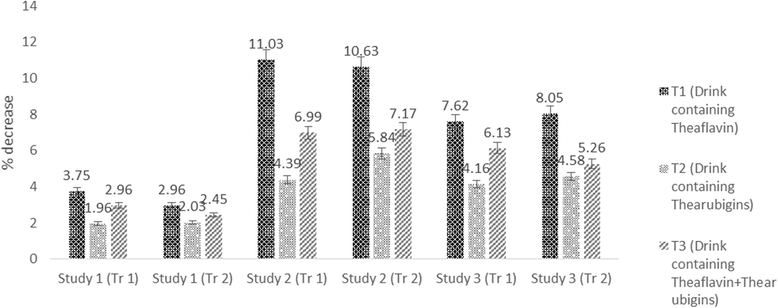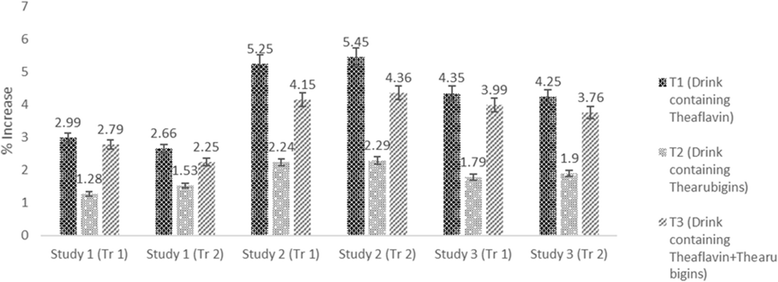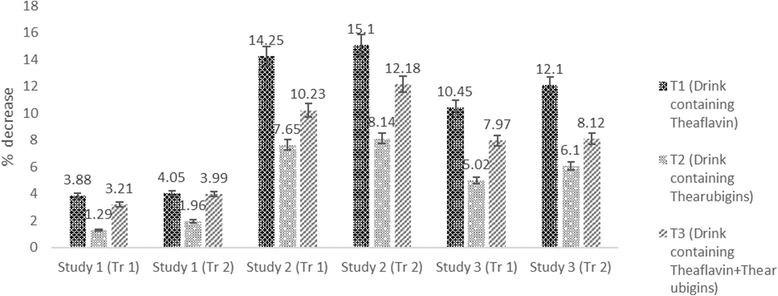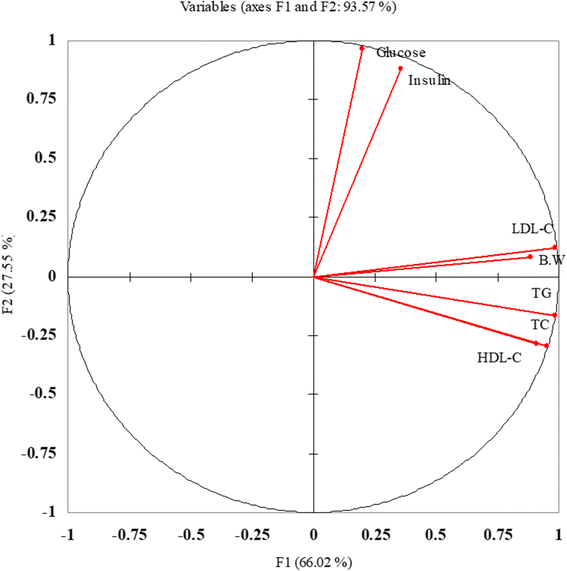Exploring the potential of black tea based flavonoids against hyperlipidemia related disorders
- PMID: 29592809
- PMCID: PMC5872535
- DOI: 10.1186/s12944-018-0688-6
Exploring the potential of black tea based flavonoids against hyperlipidemia related disorders
Abstract
Background: In recent decade, Hyperlipidemia related disorders like obesity, hypercholesterolemia and diabetes are considered as the leading killers for mankind. Fundamental nexus between nutrition and health diverting the consumers focus towards plant based natural products as a remedy against various metabolic syndrome. Considering this, present study was conducted to explicate the role of black tea polyphenols such as Theaflavins and thearubigins therapeutic potential to tackle targeted maladies especially oxidative stress related disorders like hypercholesterolemia and diabetes.
Methods: The mandate of current investigation was to explore the hypoglycemic and hypocholestrolemic perspective of isolated theaflavin and thearubigins through a model feeding trial. For the purpose, theaflavin & thearubigins were isolated from black tea through solvent partition method and utilize to form three types of nutraceutical drinks (theaflavin, thearubigins & theaflavin + thearubigins based) alongside control to be further utilized in bioefficacy trial. In bioefficacy trial, three types of independent studies were design on the bases of diet by involving 20 male wistar rats in each study (5 for each group). In study I, normal diet was administrated while, in study II & III high cholesterol and high sucrose diet was given, respectively along with prepared nutraceutical drinks to synchronize their therapeutic effect for a period of 56 days. At the termination of trial, Feed & drink intakes, body weight, total cholesterol, LDL, HDL, triglycerides, glucose and insulin levels were measured.
Results: The results indicated reduction in cholesterol, LDL and triglycerides levels of experimental rats in all studies with significant increase in HDL. In this context, theaflavin based drink imparted maximum reduction in cholesterol (3.75, 11.03 & 10.39%), LDL (3.84, 14.25& 10.84%) & triglycerides (2.99, 8.54 & 6.65%) in respective studies compared to thearubigins and theaflavin + thearubigins based drinks. However, theaflavin+ thearubigins based drink caused highest glucose decline and maximum insulin increase in all studies as compared to other nutraceutical drinks. The reported value for the insulin increase were 13.02 ± 1.02 & 14.55 ± 1.13, 10.09 ± 0.15 & 11.59 ± 0.86 for Hyperglycemic and Hypocholestrolemic rats respectively compared to control (7.84 ± 0.45 & 9.10 ± 0.41) for study I and II.
Conclusions: In the nutshell, theaflavin and thearubigins based dietary interventions are helpful to alleviate the hypercholestrolemia and hyperglycemia and should be promoted as parallel therapy to combat these disorders.
Keywords: Dietary interventions; Flavonoids; Hyperlipidemia; Thearubigins.
Conflict of interest statement
Ethics approval and consent to participate
Not applicable.
Consent for publication
Not applicable.
Competing interests
The authors declare that they have no competing interests.
Publisher’s Note
Springer Nature remains neutral with regard to jurisdictional claims in published maps and institutional affiliations.
Figures












Similar articles
-
Lipid peroxidation diminishing perspective of isolated theaflavins and thearubigins from black tea in arginine induced renal malfunctional rats.Lipids Health Dis. 2018 Jul 18;17(1):157. doi: 10.1186/s12944-018-0808-3. Lipids Health Dis. 2018. PMID: 30021615 Free PMC article.
-
Preventive role of green tea catechins from obesity and related disorders especially hypercholesterolemia and hyperglycemia.J Transl Med. 2015 Mar 4;13:79. doi: 10.1186/s12967-015-0436-x. J Transl Med. 2015. PMID: 25888764 Free PMC article.
-
Black tea polyphenols: a mechanistic treatise.Crit Rev Food Sci Nutr. 2014;54(8):1002-11. doi: 10.1080/10408398.2011.623198. Crit Rev Food Sci Nutr. 2014. PMID: 24499118 Review.
-
Catechins, theaflavins and ginger freeze-dried extract based functional drink significantly mitigate the hepatic, diabetic and lipid abnormalities in rat model.Cell Mol Biol (Noisy-le-grand). 2021 Jan 31;67(1):132-141. doi: 10.14715/cmb/2021.67.1.20. Cell Mol Biol (Noisy-le-grand). 2021. PMID: 34817356
-
Black tea: chemical analysis and stability.Food Funct. 2013 Jan;4(1):10-8. doi: 10.1039/c2fo30093a. Epub 2012 Oct 4. Food Funct. 2013. PMID: 23037977 Review.
Cited by
-
Extract of Calyces from Physalis peruviana Reduces Insulin Resistance and Oxidative Stress in Streptozotocin-Induced Diabetic Mice.Pharmaceutics. 2022 Dec 9;14(12):2758. doi: 10.3390/pharmaceutics14122758. Pharmaceutics. 2022. PMID: 36559252 Free PMC article.
-
Research Progress on the Effect and Mechanism of Tea Products with Different Fermentation Degrees in Regulating Type 2 Diabetes Mellitus.Foods. 2024 Jan 10;13(2):221. doi: 10.3390/foods13020221. Foods. 2024. PMID: 38254521 Free PMC article. Review.
-
Gut-Brain Axis in Focus: Polyphenols, Microbiota, and Their Influence on α-Synuclein in Parkinson's Disease.Nutrients. 2024 Jun 27;16(13):2041. doi: 10.3390/nu16132041. Nutrients. 2024. PMID: 38999791 Free PMC article. Review.
-
Flavonoid-Enriched Extract from Desert Plant Warionia saharae Improves Glucose and Cholesterol Levels in Diabetic Rats.Cardiovasc Hematol Agents Med Chem. 2019;17(1):28-39. doi: 10.2174/1871525717666190121143934. Cardiovasc Hematol Agents Med Chem. 2019. PMID: 30666919 Free PMC article.
-
Protective effects and molecular mechanisms of tea polyphenols on cardiovascular diseases.Front Nutr. 2023 Jun 28;10:1202378. doi: 10.3389/fnut.2023.1202378. eCollection 2023. Front Nutr. 2023. PMID: 37448666 Free PMC article. Review.
References
-
- World Health Organization . Prevalence of diabetes in the WHO eastern Mediterranean region. 2006.
-
- Schlesier K, Kühn B, Kiehntop M, Winnefeld K, Roskos M, Bitsch R, Böhm V. Comparative evaluation of green and black tea consumption on the iron status of omnivorous and vegetarian people. Food Res Int. 2012;46:522–527. doi: 10.1016/j.foodres.2011.06.019. - DOI
-
- Imran A, Butt MS, Sharif MK. Phytochemical density of some promising commercial tea brands. Int J Food Prop. 2012;15(1):99–108. doi: 10.1080/10942911003754650. - DOI
-
- Alipoor B, Rad AH. A review on the therapeutical effects of tea. Asian J Clin Nutri. 2012;4(1):1–15. doi: 10.3923/ajcn.2012.1.15. - DOI
MeSH terms
Substances
LinkOut - more resources
Full Text Sources
Other Literature Sources

